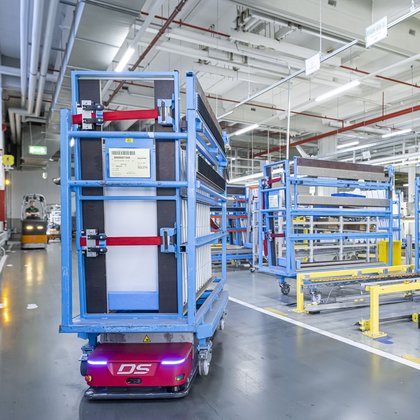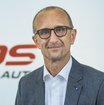In the BSH production facility in Giengen an der Brenz in Southern Germany, refrigerator and freezer doors travel quite a distance to where they are fitted to the cabinets. Their manual transport left an automation gap within the appliances’ assembly. Now an automated AGV system designed and installed by DS AUTOMOTION provides fully automatic, demand-driven door transport. Its OSCAR spin tunnel AGVs take the carriers piggyback to haul them from door assembly to the final assembly lines. This set former transport workers free for more rewarding tasks. With guaranteed on-time delivery, a reduced accident rate and in-creased energy efficiency, it also contributes to a frictionless and sustainable home appliances production.
Share article
BSH Group used DS AUTOMOTION AGV system to close Automation Gap: Cool Door Transport
Few things have changed everyday life as much as refrigerators and freezers. They enabled consumers to stock day-to-day consumer products and enjoy even delicate foods as good as fresh at a later point in time, even outside of their short harvest seasons. This changed shopping habits. Less time-consuming shopping trips at longer intervals did a lot to ease work and family reconciliation.
Refrigeration Expertise
BSH Hausgeräte GmbH (BSH), a company within the Bosch Group with around 62,000 employees, is the Europe’s biggest manufacturer, producing a complete range of modern home appliances in 40 factories around the globe. In Giengen an der Brenz, Germany, BSH has been designing and manufacturing leading-edge refrigeration appliances for more than 70 years. The 2,750 employees working in the refrigeration appliances competence center there design and produce 1.5 million refrigerators and freezers per year.
BSH embraces the manufacturing methods of Industry 4.0. The cabinets and doors are produced to order in often very small batches. The refrigerator and freezer production lines at BSH’s Giengen plant fulfill all requirements of a modern, net-zero production.
Cabinet needs Door
Each production line is comprised of two assembly lines, one for the doors and one for final assembly. The assembly lines for the refrigerator, freezer and combined fridge-freezer cabinets with the refrigeration units are located apart from the two door assembly lines. There, the doors are completed with plastic interior paneling and an insulating polyurethane core as well as a door seal. Like the refrigerators and freezers, the doors come in different sizes for one and two door, single and double winged models. In each of these lines, BSH produces about 600 doors per shift. These needed to be transported several hundred meters to their matching cabinets.
While the upstream and downstream processes were already highly automated, BSH workers transported the doors in transport cradles using side seat stackers. “This mode of transport came with certain drawbacks, binding employees badly needed for other tasks”, says Steffen Baur, Intralogistics planner at BSH. “We therefore decided to close this automation gap.”
Two AGVs in one
The local situation, particularly the restricted space at the loading and unloading stations, did nothing to make this this task easier. Prior to writing a requirement specification, BSH used supporting services of an external consultant to conduct extensive preliminary studies and analyses. When autonomous guided vehicles (AGVs) had been agreed upon as the method of choice, BSH sent a request for tender to a number of well-established AGV manufacturers.
During the tendering procedure, the wheat was quickly separated from the chaff. “We had taken three manufacturers into consideration. DS AUTOMOTION demonstrated their superior competence early, providing the most serious proposal”, Steffen Baur recalls.
“The insights on the high reliability and availability of the Systems made in Austria we gained during a visit in a large dairy plant were decisive for awarding this contract.”
DS AUTOMOTION has been solely designing and manufacturing AGV systems for nearly 40 years and was able to harness this experience in the BSH project. The exp0erts created a comprehensive system connecting both lines in a shared circuit. This ensures the best possible combination of economical and flexible AGV utilization.
On-demand Transport
One type of door per load, workers stack refrigerator and freezer doors into the carriers at the end of the door assembly lines. Upon transportation to the assigned final assembly line, they are removed by workers in one of the stations and by an industrial robot in the other for processing. The carriers are then shunted to an empty return position.
The waiting positions for the full carriers are equipped with presence sensors. If and when a final assembly line requires doors and a carrier is ready to be picked up at the assigned door assembly line, the NAVIOS fleet management software automatically creates a transport order. It commissions the AGV that is most favorably positioned to fulfill the order using the most efficient route.
Sensors are also used to monitor the empty return positions at the final assembly lines. NAVIOS automatically also includes empty return transports in its order processing. Occasionally, not all of the doors in a carrier are immediately processes. Therefore, filling level sensors at the empty return positions monitor the carriers. NAVIOS directs those that are not completely empty to specific discharging positions at the door assembly lines.
As the AGVs in four places move through fire doors, DS AUTOMOTION linked NAVIOS with BSH’s central fire alarm system. They also integrated several hazard lights and a traffic light.
Safe Transport
Eight tunnel AGVs from DS AUTOMOTION’s OSCAR family carry out the transport. They carry the door carriers piggyback. BSH purchased these standardized, custom trolleys as part of the door transport automation project. Depending on their height, the doors are loaded in one or two levels in a standing position, leaning against horizontal struts. To prevent them from shifting in the event of abrupt braking, the carriers are invariably moved with these struts ahead. At the stations, however, the trolleys are parked with the doors ahead to provide workers or the robot with better access for unloading. This and the loading and unloading positions at a right angle to the rather narrow corridors prompted DS AUTOMOTION to select the OSCAR spin AGV model that can handle tight curves and rotate on the spot.
“OSCAR AGVs can use contour-based navigation (SLAM) and do not need specifically installed landmarks”, says Karl Rapp, division manager sales, product management and marketing at DS AUTOMOTION. “To improve precision in some areas, we also installed magnets in the floor at precise position in the layout.”
The OSCARS use corridors that were not specifically prepared for AGV traffic. Its rugged design with 25 mm ground clearance and a solid drive train lend OSCAR the uncompromised suitability for industrial applications, including the ability to handle uneven factory floors.
The AGVs share the corridors with various other users. Among these are pedestrians with or without pallet trucks, manned forklift trucks, milk run tugger trains and bicycle riders. They communicate with their environment using seamlessly integrated LED lamps. Along with the vehicles’ underbody lighting, this is sure to catch everyone’s attention. The AGVs travelling at 1.2 meters per second ensure safety for people in the corridors, featuring two integrated 180-degree safety laser scanners and kick strips for areas where the scanners need to be deactivated. Front and rear time-of-flight (ToF) cameras add a third dimension to the robots’ vision to reliably prevent collisions with elevated objects such as loads suspended on forklifts or on tugger trains.
Innovative waiting and charging concept
OSCAR charges its integrated batteries using floor contacts. At BSH, these are installed at some of the AGV waiting positions at one of the final assembly lines, so charging does not require extra time. While at one of the door assembly lines, there is ample room for parking full trolleys. At the other line, the waiting positions are located across the corridor so traffic is not held up by waiting vehicles. These positions are also used for charging. Consequently, the AGVs hardly ever need to take pauses for charging.
“The DS AUTOMOTION installation enabled us to fully automate door transport between two refrigerator and freezer lines”, Steffen Baur concludes. “With remarkable competences and experience, the company mastered our challenges, taking several optimizing steps and making the system a blazing success.”


